
Deposition Date
2018-01-31
Release Date
2018-07-25
Last Version Date
2024-11-13
Entry Detail
PDB ID:
5Z89
Keywords:
Title:
Structural basis for specific inhibition of highly sensitive ShHTL7 receptor
Biological Source:
Source Organism:
Striga hermonthica (Taxon ID: 68872)
Host Organism:
Method Details:
Experimental Method:
Resolution:
1.42 Å
R-Value Free:
0.12
R-Value Work:
0.10
R-Value Observed:
0.10
Space Group:
P 65


